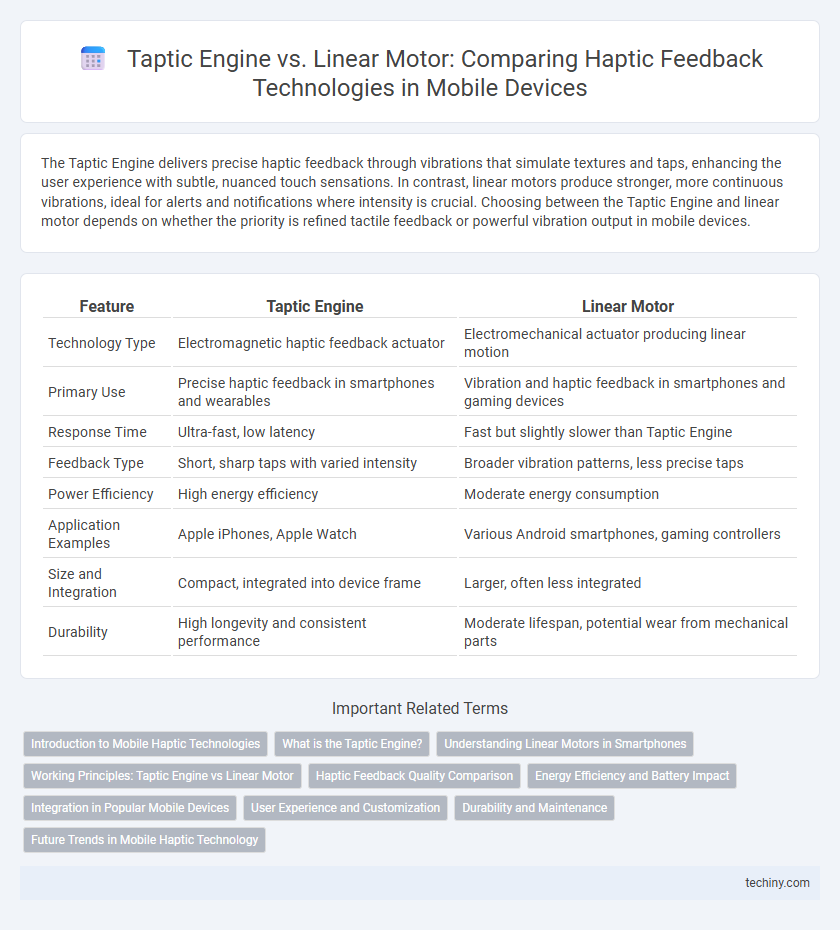The Taptic Engine delivers precise haptic feedback through vibrations that simulate textures and taps, enhancing the user experience with subtle, nuanced touch sensations. In contrast, linear motors produce stronger, more continuous vibrations, ideal for alerts and notifications where intensity is crucial. Choosing between the Taptic Engine and linear motor depends on whether the priority is refined tactile feedback or powerful vibration output in mobile devices.
Table of Comparison
| Feature | Taptic Engine | Linear Motor |
|---|---|---|
| Technology Type | Electromagnetic haptic feedback actuator | Electromechanical actuator producing linear motion |
| Primary Use | Precise haptic feedback in smartphones and wearables | Vibration and haptic feedback in smartphones and gaming devices |
| Response Time | Ultra-fast, low latency | Fast but slightly slower than Taptic Engine |
| Feedback Type | Short, sharp taps with varied intensity | Broader vibration patterns, less precise taps |
| Power Efficiency | High energy efficiency | Moderate energy consumption |
| Application Examples | Apple iPhones, Apple Watch | Various Android smartphones, gaming controllers |
| Size and Integration | Compact, integrated into device frame | Larger, often less integrated |
| Durability | High longevity and consistent performance | Moderate lifespan, potential wear from mechanical parts |
Introduction to Mobile Haptic Technologies
The Taptic Engine and Linear Motor represent key advancements in mobile haptic technologies, enhancing user experience through precise tactile feedback. The Taptic Engine, pioneered by Apple, offers nuanced vibrations by utilizing a linear actuator designed for quick, subtle pulses to simulate realistic touch sensations. Linear motors, commonly found in various Android devices, deliver consistent haptic feedback through electromagnetic actuation, providing strong and uniform vibrations suited for notifications and gaming applications.
What is the Taptic Engine?
The Taptic Engine is a haptic feedback mechanism developed by Apple that uses linear actuators to create precise, nuanced vibrations, enhancing user interaction on devices like iPhones and Apple Watches. Unlike traditional linear motors, the Taptic Engine offers faster response times and more localized tactile sensations by delivering controlled pulses instead of continuous vibrations. This technology enables realistic feedback for virtual buttons, notifications, and alerts, improving the overall sensory experience on mobile devices.
Understanding Linear Motors in Smartphones
Linear motors in smartphones deliver precise haptic feedback by moving a magnet along a single axis, creating strong and consistent vibrations that enhance user experience in gaming and notifications. Unlike traditional Taptic Engines that use a rotating mass to generate vibrations, linear motors provide quicker response times and finer control over intensity and frequency. This technology allows manufacturers to design slimmer devices with improved tactile interactions, significantly elevating smartphone usability and immersion.
Working Principles: Taptic Engine vs Linear Motor
The Taptic Engine utilizes a rotating mass driven by a voice coil actuator to create precise haptic feedback through vibration patterns, enhancing user interaction by simulating touch sensations. In contrast, the Linear Motor operates by moving a magnetic mass linearly along a track using electromagnetic forces, delivering more immediate and varied tactile responses with higher force output. These distinct working principles define their applications in mobile devices, where the Taptic Engine is favored for nuanced feedback and the Linear Motor for stronger, directional haptics.
Haptic Feedback Quality Comparison
The Taptic Engine delivers precise, sharp haptic feedback with distinct pulses that enhance user interaction through refined vibration patterns, often found in Apple devices. Linear motors produce smoother and more continuous vibrations, ideal for immersive gaming experiences but sometimes perceived as less tactile than the Taptic Engine's crisp response. Overall, Taptic Engines excel in creating nuanced, localized haptic sensations, while linear motors prioritize broader, more fluid feedback suitable for dynamic touch interactions.
Energy Efficiency and Battery Impact
The Taptic Engine in mobile devices offers precise haptic feedback with lower power consumption compared to traditional linear motors, leading to improved energy efficiency and reduced battery drain. Linear motors typically require more energy due to their mechanical movement range and force output, which can shorten battery life during prolonged usage. Optimizing haptic feedback through Taptic Engine technology significantly enhances user experience while maintaining better overall device battery performance.
Integration in Popular Mobile Devices
The Taptic Engine is widely integrated into Apple devices such as iPhones and Apple Watches, delivering precise haptic feedback through electromagnetic actuators that simulate tactile sensations. In contrast, linear motors are commonly found in flagship Android smartphones from brands like Samsung and OnePlus, providing strong, smooth vibration for notifications and gaming experiences. Both technologies optimize user interaction by enhancing touch response, but their integration depends on device design priorities and ecosystem compatibility.
User Experience and Customization
The Taptic Engine delivers precise haptic feedback with varying vibration intensities, enhancing user experience through nuanced touch sensations in Apple devices. Linear motors provide smoother and quicker responses, allowing for customizable vibration patterns tailored to individual preferences on a range of Android smartphones. Both technologies improve tactile interaction, but the Taptic Engine excels in subtlety while linear motors offer greater adaptability for personalized feedback.
Durability and Maintenance
The Taptic Engine, renowned for its precise haptic feedback, generally offers higher durability due to its robust electromagnetic actuator design that resists wear over time. In contrast, linear motors, which rely on moving parts like sliders or coils, may experience more frequent mechanical degradation, leading to increased maintenance needs. Choosing between the two depends on the required longevity and the specific maintenance capacity of the mobile device.
Future Trends in Mobile Haptic Technology
Future trends in mobile haptic technology indicate a shift towards more immersive and precise feedback systems, with Taptic Engines offering nuanced vibrations that simulate various textures and sensations. Linear motors provide rapid, stronger haptic responses, enhancing gaming and virtual reality experiences through detailed tactile feedback. Advancements in materials and AI integration are expected to further optimize the performance of both Taptic Engines and linear motors, driving next-generation mobile interaction designs.
Taptic Engine vs Linear motor Infographic

 techiny.com
techiny.com